Abstract
Purpose
The goals in this study were several-fold. First, to optimize the in vivo phage display methodology by incorporating phage pharmacokinetic properties, to isolate peptides that target the brain microvasculature, and then to build focused libraries to obtain structure activity relationship information in vivo to identify the optimal targeting motif.
Materials and Methods
The blood pharmacokinetics of filamentous and T7 phage were evaluated to choose the optimal platform. A randomized peptide library with a motif CX10C was constructed in T7 phage and used for in vivo panning. Focused peptide libraries around each structural element of the brain-specific peptide were constructed to perform kinetic structure activity relationship (kSAR) analysis in vivo. To determine potential function, sepsis was induced in mice by LPS administration and four hours later the effect of GST-peptide on adhesion of rhodamine-labelled lymphocytes or CFDA-labelled platelets to pial microvasculature was observed by intravital microscopy.
Results
The blood phamacokinetics of T7 was rapid (half-life of 12 min) which aids the clearance of non-specific phage. In vivo panning in brain enriched for isolates expressing the motif CAGALCY. Kinetic analysis of focused libraries built around each structural element of the peptide provided for rapid pharmacophore mapping. The computer modeling data suggested the peptide showed similarities to peptide mimetics of adhesion molecule ligands. GST-CAGALCY but not GST control protein was able to inhibit the rolling and adhesion of labeled platelets to inflamed pial vasculature. GST-CAGALCY had no effect on lymphocyte adhesion.
Conclusions
Incorporating normal blood phamacokinetics of T7 phage into in vivo phage display improves the ability to recover targeting peptide motifs and allows effective lead optimization by kSAR. This approach led to the isolation of a brain-specific peptide, CAGALCY, which appears to function as an effective antagonist of platelet adhesion to activated pial microvasculature.






Similar content being viewed by others
Abbreviations
- CFDA:
-
carboxyfluorescein diacetate succinimidyl ester
- GST:
-
glutathione S-transferase
- IPTG:
-
Isopropyl β-D-1-thiogalactopyranoside
- KSAR:
-
kinetic structure activity relationship
- LPS:
-
Lipopolysaccharide
- MPS:
-
monophagocytic system
- PEG:
-
polyethylene glycol
References
P. R. Streeter, E. L. Berg, B. T. N. Rouse, R. F. Bargatze, and E. C. Butcher. A tissue-specific endothelial cell molecule involved in lymphocyte homing. Nature 331:41–46 (1988).
L. A. Lasky. Selectins: interpreters of cell-specific carbohydrate information during inflammation. Science 258:964–969 (1992).
T. M. Carlos and J. M. Harlan. Leukocyte-endothelial adhesion molecules. Blood 84:2068–2101 (1994).
M. Salmi and S. Jalkanen. How do lymphocytes know where to go: current concepts and enigmas of lymphocyte homing. Adv. Immunol. 64:139–218 (1997).
E. C. Butcher and L. J. Picker. Lymphocyte homing and homeostasis. Science 272:60–66 (1996).
R. O. Hynes. Integrins: bidirectional, allosteric signaling machines. Cell 110:673–687 (2002).
P. Kubes and P. A. Ward. Leukocyte recruitment and the acute inflammatory response. Brain Pathol. 10:127–135 (2000).
C. Robert and T. S. Kupper. Inflammatory skin diseases, T cells, and immune surveillance. N. Engl. J. Med. 341:1817–1828 (1999).
T. A. Springer. Traffic signals on endothelium for lymphocyte recirculation and leukocyte emigration. Annu. Rev. Physiol. 57:827–872 (1995).
U. H. von Andrian and C. R. Mackay. T-cell function and migration. Two sides of the same coin. N. Engl. J. Med. 343:1020–1034 (2000).
R. P. McEver. Adhesive interactions of leukocytes, platelets, and the vessel wall during hemostasis and inflammation. Thromb. Haemost. 86:746–756 (2001).
W. C. Aird. The role of the endothelium in severe sepsis and multiple organ dysfunction syndrome. Blood 101:3765–3777 (2003).
J. N. George, J. E. Sadler, and B. Lammle. Platelets: thrombotic thrombocytopenic purpura. Hematology (Am. Soc. Hematol. Educ. Program) 1:315–334 (2002).
J. L. Moake. Thrombotic microangiopathies. N. Engl. J. Med. 347:589–600 (2002).
R. Pasqualini and E. Ruoslahti. Organ targeting in vivo using phage display peptide libraries. Nature 380:364–366 (1996).
D. Rajotte, W. Arap, M. Hagedorn, E. Koivunen, R. Pasqualini, and E. Ruoslahti. Molecular heterogeneity of the vascular endothelium revealed by in vivo phage display. J. Clin. Invest. 102:430–437 (1998).
W. Arap, R. Pasqualini, and E. Ruoslahti. Cancer treatment by targeted drug delivery to tumor vasculature in a mouse model. Science 279:377–380 (1998).
E. Ruoslahti and D. Rajotte. An address system in the vasculature of normal tissues and tumors. Annu. Rev. Immunol. 18:813–827 (2000).
T. M. Allen. Interactions of liposomes and other drug carriers with the mononuclear phagocyte system. In G. Gregoriadis (ed.), Liposomes as Drug Carriers, Recent Trends and Progress, Wiley, Chichester, 1988, pp. 37–50.
F. Nilsson, L. Tarli, F. Viti, and D. Neri. The use of phage display for the development of tumour targeting agents. Adv. Drug. Deliv. Rev. 43:165–196 (2000).
Y. L. Yip, N. J. Hawkins, G. Smith, and R. L. Ward. Biodistribution of filamentous phage-Fab in nude mice. J. Immunol. Methods 225:171–178 (1999).
J. O’Malley, L. E. Matesic, M. C. Zink, J. D. Strandberg, M. L. Mooney, A. De Maio, and R. H. Reeves. Comparison of acute endotoxin-induced lesions in A/J and C57BL/6J mice. J. Heredity 89:525–530 (1998).
D. G. Abraham, E. M. Nutt, R. A. Bednar, B. Bednar, R. J. Gould, and L. T. Duong. Arginine-glycine-aspartic acid mimics can identify a transitional activation state of recombinant alphaIIb beta3 in human embryonic kidney 293 cells. Mol. Pharmacol. 52:227–236 (1997).
B. K. Blackburn, A. Lee, M. Baier, B. Kohl, A. G. Olivero, R. Matamoros, K. D. Robarge, and R. S. McDowell. From peptide to non-peptide. 3. Atropisomeric GPIIbIIIa antagonists containing the 3,4-dihydro-1H-1,4-benzodiazepine-2,5-dione nucleus. J. Med. Chem. 40:717–729 (1997).
N. J. Dubree, D. R. Artis, G. Castanedo, J. Marsters, D. Sutherlin, L. Caris, K. Clark, S. M. Keating, M. H. Beresini, H. Chiu, S. Fong, H. B. Lowman, N. J. Skelton, and D. Y. Jackson. Selective alpha4beta7 integrin antagonists and their potential as anti-inflammatory agents. J. Med. Chem. 45:3451–3457 (2002).
M. S. Egbertson, C. T. Chang, M. E. Duggan, R. J. Gould, W. Halczenko. G. D. Hartman, W. I. Laswell, J. J. Lynch, R. J. Lynch, and P. D. Manno. Non-peptide fibrinogen receptor antagonists. 2. Optimization of a tyrosine template as a mimic for Arg-Gly-Asp. J. Med. Chem. 37:2537–2551 (1994).
T. R. Gadek, D. J. Burdick, R. S. McDowell, M. S. Stanley, J. C. Marsters Jr., K. L. Paris, D. A. Oare, M. E. Reynolds, C. Ladner, K. A. Zioncheck, W. P. Lee, P. Gribling, W. Dennis, L. G. Presta, and S. C. Bodary. Generation of an LFA-1antagonist by the transfer of the ICAM-1 immunoregulatory epitope to a small molecule. Science 295:1086–1089 (2002).
M. Gurrath, G. Muller, H. Kesslar, M. Aumailley, and R. Timpl. Conformation/activity studies of rationally designed potent anti-adhesive RGD peptides. Eur. J. Biochem. 210:911–921 (1992).
R. Haubner, H. J. Wester, F. Burkhart, R. Senekowitsch-Schmidtke, W. Weber, S. L. Goodman, H. Kessler, and M. Schwaiger. Glycosylated RGD-containing peptides: tracer for tumor targeting and angiogenesis imaging with improved biokinetics. J. Nucl. Med. 42:326–336 (2001).
D. Y. Jackson, C. Quan, R. R. Artis, T. Rawson, B. Blackburn, M. Struble, G. Fitzgerald, K. Chan, S. Mullins, J. P. Burnier, W. J. Fairbrother, K. Clark, M. Berisini, H. Chui, M. Renz, S. Jones, and S. Fong. Protein alpha 4 beta 1 peptide antagonists as potential anti-inflammatory agents. J. Med. Chem. 40:3359–3368 (1997).
D. Y. Jackson. Alpha 4 integrin antagonists. Curr. Pharm. Des. 8:1229–1253 (2002).
R. J. Kok, A. J. Schraa, E. J. Bos, H. E. Moorlag, S. A. Asgeirsdottir, M. Everts, D. K. Meijer, and G. Molema. Preparation and functional evaluation of RGD-modified proteins as alpha(v)beta(3) integrin directed therapeutics. Bioconjug. Chem. 13:128–135 (2002).
I. Sircar, K. S. Gudmundsson, R. Martin, J. Liang, S. Nomura, H. Jayakumar, B. R. Teegarden, D. M. Nowlin, P. M. Cardarelli, J. R. Mah, S. Connell, R. C. Griffith, and E. Lazarides. Synthesis and SAR of N-benzoyl-L-bipheylalanine derivatives: discovery of TR-14035, a dual alpha(4)beta(7)/alpha(4)beta(1) integrin antagonist. Bioorg. Med. Chem. 10:2051–2066 (2002).
D. M. Huryn, A. W. Konradi, S. Ashwell, S. B. Freedman, L. J. Lombardo, M. A. Pleiss, E. D. Thorsett, T. Yednock, and J. D. Kennedy. The identification and optimization of orally efficacious, small molecule VLA-4 antagonists. Curr. Top. Med. Chem. 4:1473–1484 (2004).
J. K. Seydel. Sulfonamides, structure-activity relationship, and mode of action. Structural problems of the antibacterial action of 4-aminobenzoic acid (PABA) antagonists. J. Pharm. Sci. 57:1455–1478 (1968).
M. S. Tute. Principles and practice of Hansch analysis: a guide to structure-activity correlation for the medicinal chemist. Adv. Drug Res. 6:1–77 (1971).
Y. C. Martin. Theoretical basis of medicinal chemistry: structure activity relationships and three dimensional structures of small and macromolecules. In Y. C. Martin, V. Austel, and E. Kutter (eds.), Modern Drug Research. Paths to Better and Safer Drugs, Marcel Dekker, New York, 1989, pp 161–216.
Alchemy 2000. Tripos Inc., St Louis, Missouri, http://www.tripos.com.
ArgusLab 4.0.1 Mark A. Thompson, Planaria Software LLC, Seattle, WA http://www.arguslab.com.
Acknowledgments
The authors thank Jie Li and Clara Polizzi for their technical assistance with the intravital microscopy studies and Zhe Li, Shaan Tolani, and Zaid Yusufi for technical assistance with the phage display work. The intravital microscopy studies were supported in part by NIH grant A140667-06 to HvdH.
Author information
Authors and Affiliations
Corresponding author
Additional information
Targeted Molecules Corp. is now a wholly owned subsidiary of Chromos Molecular Systems Inc, 8081 Lougheed Highway, Burnaby, BC, V5A 1W9, Canada.
Rights and permissions
About this article
Cite this article
Fan, X., Venegas, R., Fey, R. et al. An In Vivo Approach to Structure Activity Relationship Analysis of Peptide Ligands. Pharm Res 24, 868–879 (2007). https://doi.org/10.1007/s11095-007-9238-z
Received:
Accepted:
Published:
Issue Date:
DOI: https://doi.org/10.1007/s11095-007-9238-z




